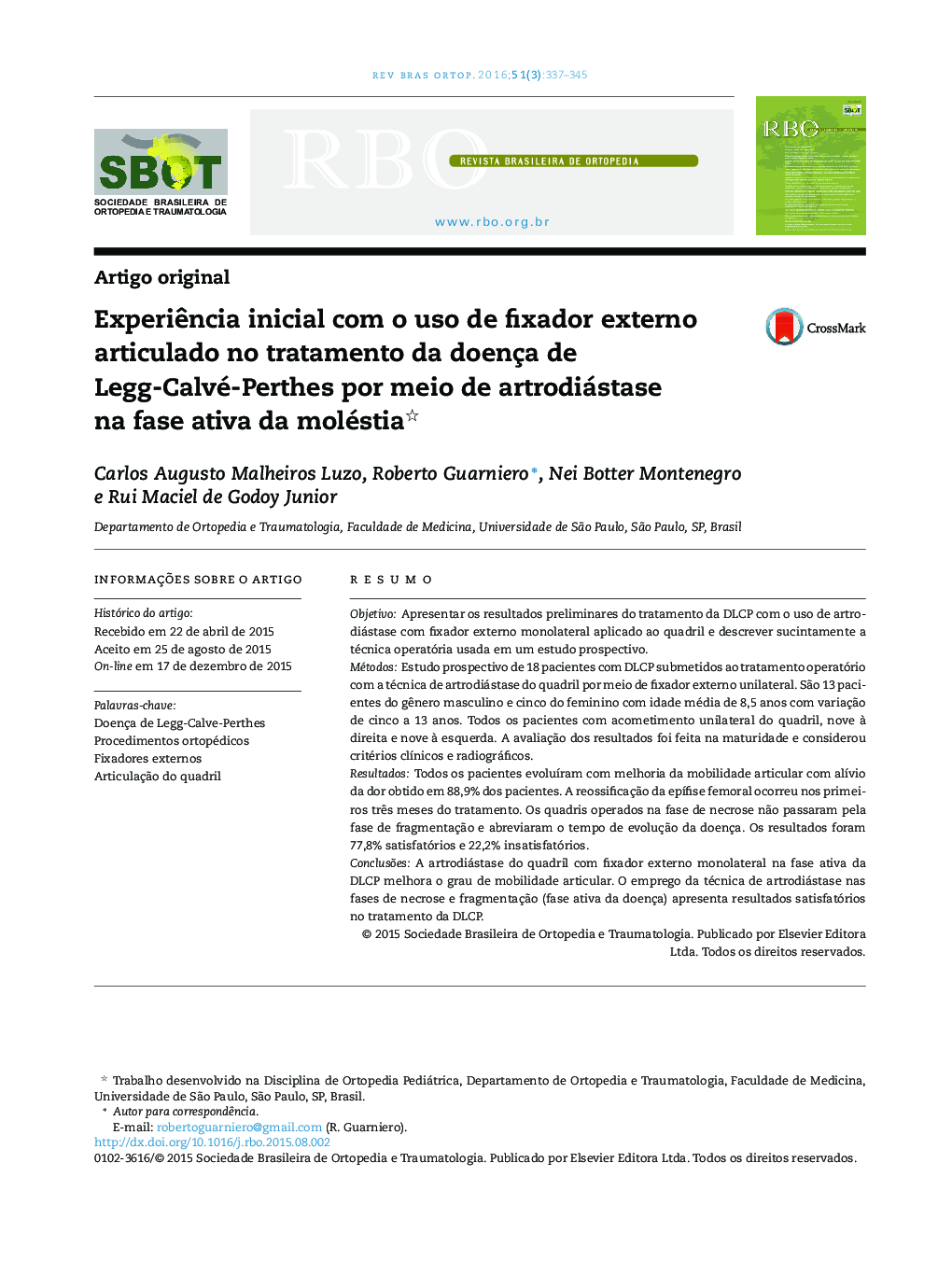| کد مقاله | کد نشریه | سال انتشار | مقاله انگلیسی | نسخه تمام متن |
|---|---|---|---|---|
| 2707394 | 1144851 | 2016 | 9 صفحه PDF | دانلود رایگان |

ResumoObjetivoApresentar os resultados preliminares do tratamento da DLCP com o uso de artrodiástase com fixador externo monolateral aplicado ao quadril e descrever sucintamente a técnica operatória usada em um estudo prospectivo.MétodosEstudo prospectivo de 18 pacientes com DLCP submetidos ao tratamento operatório com a técnica de artrodiástase do quadril por meio de fixador externo unilateral. São 13 pacientes do gênero masculino e cinco do feminino com idade média de 8,5 anos com variação de cinco a 13 anos. Todos os pacientes com acometimento unilateral do quadril, nove à direita e nove à esquerda. A avaliação dos resultados foi feita na maturidade e considerou critérios clínicos e radiográficos.ResultadosTodos os pacientes evoluíram com melhoria da mobilidade articular com alívio da dor obtido em 88,9% dos pacientes. A reossificação da epífise femoral ocorreu nos primeiros três meses do tratamento. Os quadris operados na fase de necrose não passaram pela fase de fragmentação e abreviaram o tempo de evolução da doença. Os resultados foram 77,8% satisfatórios e 22,2% insatisfatórios.ConclusõesA artrodiástase do quadril com fixador externo monolateral na fase ativa da DLCP melhora o grau de mobilidade articular. O emprego da técnica de artrodiástase nas fases de necrose e fragmentação (fase ativa da doença) apresenta resultados satisfatórios no tratamento da DLCP.
ObjectiveTo present the preliminary results from treating patients with Legg‐Calvé‐Perthes Disease (LCPD) by means of hip arthrodiastasis using a monolateral external fixator applied to the hip and to succinctly describe the surgical technique used, in a prospective study.MethodsProspective study on 18 patients with LCPD who underwent surgical treatment by means of the hip arthrodiastasis technique using a monolateral external fixator. There were 13 male and five female patients of mean age 8.5 years, ranging from five to 13 years. All the patients presented unilateral hip impairment: nine on the right side and nine on the left. The results were evaluated at maturity using clinical and radiological criteria.ResultsAll the patients evolved with improvement of joint mobility, and pain relief was achieved in 88.9% of them. Reossification of the femoral epiphysis occurred within the first three months of the treatment. The hips operated at the necrosis stage of the disease did not passed through the fragmentation stage, thus shortening the evolution of the disease. The results were 77.8% satisfactory and 22.2% unsatisfactory.ConclusionHip arthrodiastasis with a monolateral external fixator during the active phase of LCPD improved the degree of joint mobility. Use of the arthrodiastasis technique at the necrosis stage or at the fragmentation stage (active phase of the disease) presented satisfactory results from treatment of LCPD.
Journal: Revista Brasileira de Ortopedia - Volume 51, Issue 3, May–June 2016, Pages 337–345